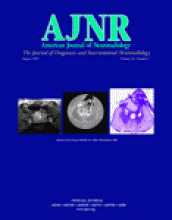We fully agree with Raymond et al (1) that “new embolic agents should first demonstrate safety characteristics that are equivalent to standard platinum coils before considering a widespread application” and “worse, their use could be associated with early rebleeding when lesions are treated after rupture” (p. 1129).
These concerns are even more important and urgent when companies of embolic agents provide us with questionable interpretations of study results. In the 2004 Matrix Newsletter, the results of the so-called ACTIVE Study are presented (2). Matrix coils are coated with a biologically active substance and proved to accelerate healing of intracranial aneurysms in swine, and it is concluded that these coils may prevent aneurysmal recanalization after endovascular treatment of cerebral aneurysms (3).
The first page of the newsletter states, “The ACTIVE Study represents the first prospective multicenter trial designed to evaluate the benefit of the Matrix Detachable Coil for the treatment of cerebral aneurysms and was sponsored by Boston Scientific, Neurovascular, Fremont, CA.”
On the second page, it is reported that 3% of the patients treated with Matrix coils suffered a fatal early rebleeding (three of 100). On closer inspection, however, only 44 of these 100 patients were treated after aneurysmal rupture. Thus, the early fatal rebleeding rate should have been reported to be 7% (three of 44) instead of 3%. In the ISAT study (4), in which the patients were treated with standard platinum coils, 10 of 1005 patients suffered an early rebleeding after coiling of a ruptured aneurysm (1%).
Apart from the fact that this 7% of rebleeding rate after treatment with Matrix is unacceptably high, these findings are not surprising after review of the remaining part of the newsletter: it is reported that 67% of the coiled aneurysms still show residual aneurysm filling on the immediate postembolization angiogram. On the 12-month follow-up angiogram, 49% of the aneurysms show “progressive thrombosis.” Apparently the Matrix coils allow residual filling of the aneurysmal sac over an unknown period of time and during this period the patient is not protected against a rebleeding.
In the evaluation of these new coils that possibly improve long-term results, the most important goal of ruptured aneurysm treatment—that is, to exclude the aneurysm from the circulation to prevent early rebleeding—is clearly ignored.
So do these new coils at least perform better in the long term than they were designed to? On page 3, the results of follow-up angiography after 12 months are discussed. In a complex and confusing way, an attempt is made to compare these findings on follow-up with historical data, but in a presentation by the company we find out that 16% of the followed patients had to be retreated with coils (5). The retreatment rate after treatment with standard platinum coils is in the range of 10% (6).
The conclusion of the ACTIVE Study should therefore not be that “the results of 1st treatment with 1st Generation Matrix Detachable Coils are favorable,” but that Matrix coils offer no benefit over standard platinum coils and that these coils should not be used to treat recently ruptured cerebral aneurysms.
- Copyright © American Society of Neuroradiology












